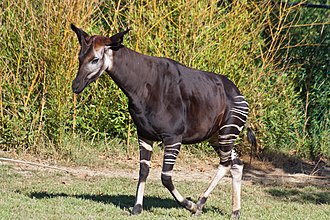- Okapi, also known as the “forest giraffe” or “zebra giraffe,” is a unique mammal found in the dense rainforests of the Democratic Republic of Congo.
- They are closely related to giraffes but have a much shorter neck and lack the long legs.
- Okapi have a dark brown or black body with striking white horizontal stripes on their hindquarters, resembling a zebra.
- They have large, flexible ears that can rotate independently to detect sounds in their surroundings.
- Okapi possess a long, prehensile tongue that can reach up to 18 inches (45 cm) to help them strip leaves from branches.
- They have a velvety, oily coat that provides protection against moisture and insects in their dense forest habitat.
- Okapi have scent glands on their feet that leave behind a sticky substance as they walk, allowing them to mark their territory.
- They are primarily solitary animals, with males and females coming together only for mating.
- Okapi are herbivores, feeding on a diet consisting mainly of leaves, buds, fruits, and grasses.
- They have a gestation period of about 14 to 15 months, one of the longest of any mammal.
- Okapi calves are born with a white stripe pattern on their bodies, which gradually changes to the adult coloration over time.
- They are known for their elusive nature and are difficult to observe in the wild due to their secretive behavior.
- Okapi are excellent swimmers and are known to cross rivers and streams when necessary.
- They have a keen sense of hearing and can detect sounds from long distances, helping them avoid predators.
- Okapi have been observed using their long tongues to clean their eyes and ears, as well as groom their bodies.
- They are important seed dispersers in their ecosystem, as undigested seeds from the fruits they consume are excreted in different locations.
- Okapi have been listed as endangered due to habitat loss, hunting, and civil unrest in their native range.
- They have a lifespan of about 20 to 30 years in the wild and can live even longer in captivity.
- Okapi communicate through vocalizations, including a variety of low-frequency sounds, snorts, and bellows.
- They have a complex social structure, with overlapping home ranges and scent marking used for communication.
- Okapi have a unique adaptation known as “infra-sound,” producing low-frequency vocalizations that can travel long distances through dense vegetation.
- They have been studied for their ability to detect seismic vibrations, which allows them to sense approaching threats or detect nearby individuals.
- Okapi possess scent glands on their feet that help them navigate through their environment and communicate with other okapi.
- They have a strong sense of smell and use scent marking to establish their presence and communicate with other individuals.
- Okapi have a specialized stomach chamber called the “forestomach” that aids in digesting the tough plant material they consume.
- They are excellent climbers and can navigate through dense vegetation and steep slopes with agility.
- Okapi have been known to use their horns to clear pathways through thick vegetation or for defense against predators.
- They have a calm and gentle temperament, rarely showing aggression unless threatened.
- Okapi are considered a flagship species for conservation efforts in the Congo Basin rainforests.
- They are known to groom themselves using their tongue and lips, similar to the behavior of giraffes.
- Okapi are active during the day, spending much of their time browsing for food and exploring their habitat.
- They have specialized molars and premolars adapted for grinding tough vegetation.
- Okapi have been known to rub their necks and bodies against trees, possibly for scent marking or parasite control.
- They have a keen sense of balance, allowing them to navigate uneven terrain and cross fallen logs with ease.
- Okapi are highly sensitive to changes in their environment, making them good indicators of the overall health of the rainforest ecosystem.
- They are capable of running at speeds of up to 35 miles per hour (56 km/h) when necessary.
- Okapi have a unique adaptation known as “facial glands,” which produce a sticky, tar-like substance that they use for marking their territory.
- They have been known to form temporary associations with other herbivores, such as forest elephants or African buffalo, to enhance their foraging success and protection against predators.
- Okapi are known for their distinct vocalizations, including a series of cough-like sounds and deep roars.
- They have a close relationship with local indigenous people, with traditional folklore and beliefs incorporating the okapi into their cultural heritage.
- Okapi have been studied for their role as seed dispersers, helping to maintain the biodiversity of the rainforest by spreading seeds to different areas.
- They have a highly developed sense of touch, with specialized nerve endings in their muzzle and lips.
- Okapi are excellent navigators, often relying on their memory and spatial awareness to find food and locate resources in their complex forest environment.
- They have a unique breeding behavior, where males establish and defend small territories known as “lekking areas” to attract females for mating.
- Okapi are known to be very selective in their food choices, often avoiding plants with high toxic or alkaloid content.
- They have a distinctive scent that is often described as musky or earthy, which helps them communicate with other okapi and mark their territory.
- Okapi have been the focus of conservation initiatives, with protected areas established to safeguard their populations and habitat.
- They have a large home range that can cover several square kilometers, allowing them to access sufficient food resources.
- Okapi have been featured in zoos and wildlife parks worldwide, serving as ambassadors for the conservation of their wild counterparts.
- They are fascinating creatures with a unique appearance and ecological role, captivating the interest of researchers, conservationists, and nature enthusiasts alike.
Facebook Comments

































